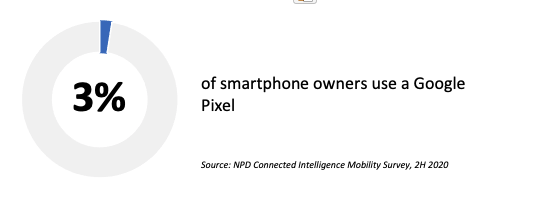
The Pixel strikes back
Google last week announced the upcoming availability of its new Pixel smartphone lineup, the new Pixel 6 and Pixel 6 Pro, via a teaser webpage and Twitter. The debut medium selection may be unconventional, but what makes the new phones truly unconventional is what Google placed under the hood. The new Pixel series will be powered by Google’s own SoC (System-on-Chip) solution dubbed Tensor. Google’s teaser video/thread/blog talks extensively about how the new silicon will run machine-learning and artificial-intelligence algorithms to enhance phone’s imaging and speech-recognition capabilities. Google was quite tight-lipped regarding the phones’ features, apart from revealing that the Pixel 6 Pro will boast a 6.7-inch QHD+ display with a 120Hz refresh rate, while the entry-level version Pixel 6 will have a 6.4-inch FHD+ screen with a 90Hz refresh rate. Google also shared that the Pro version would house a 4X optical-zoom folded telephoto lens, which would not appear on the Pixel 6. The new Pixel 6 series’ pricing and launch date are unclear, though Google promised a “fall” debut.
The NPD Take:
- When Google introduced the Pixel 5 5G and 4A 5G last year were disappointed to see Google giving up on the flagship market and focus efforts in the affordable segment with a mediocre lineup. The new Pixel 6 series’ specs (or at least those that we know of) including the homegrown processor, outstanding design features such as the camera bump in the back, are clear statements that Google wants to take another shot in the flagship Android market, which desperately needs new contenders and extra innovation to stop the migration to Apple, and balance Samsung’s growing dominance.
- U.S. carriers, especially Verizon, have given Google considerable marketing support with the hope of having a premium category contender for range diversification, but the predecessor Pixel series had not been able to build a substantial base of followers. To Google’s luck, U.S. carriers have limited alternatives to push against Samsung and Apple, thus the new Pixel 6 series flagships should again enjoy considerable marketing support assuming the new Tensor solution will be on par with the high-end Snapdragon chipset performances.
Metro goes after Boost and Cricket subs
Metro by T-Mobile last week announced a new campaign targeting prepaid rivals’ customers. The new campaign offers features an unlimited data plan priced at $25/month as well as a free Samsung Galaxy A32 5G smartphone. The carrier’s marketing directly targets Boost and Cricket customers by claiming that they can lower their bills by half by switching to Metro. The new rate plan requires the port-in of an existing line by another carrier (excluding T-Mobile postpaid) as well as the trade-in of any phone in working condition. Notably, subscribers of the new plan will be throttled/deprioritized once their consumption exceeds 35 GB during a bill cycle. The new plan also lacks the mobile hotspot option and limits video streaming to 480p resolution. Finally, users are required to visit a dealer door as the offer is not available for online purchases.
The NPD Take:
- Metro’s new campaign is one of the most aggressive switcher campaigns we’ve seen in a long time. The $25/month unlimited plan, despite the limitations such as the 480p video streaming resolution and the lack of mobile hotspot, should attract the high-end plan subscribers at Boost, Cricket and StraightTalk. The throttle limit of 35 GB cellular data should also be fine with the majority of prepaid customers as an average prepaid customer consumes only a third of this amount.
- The addition of the free Samsung Galaxy A32 5G to the promo mix will help Metro (therefore T-Mobile) further extend its lead in 5G device adoption rates. Prepaid customers show as much as interest (as postpaid customers) in upgrading to a 5G smartphone when it’s to replace their phones.
T-Mobile and cable MVNOs continue to shine
T-Mobile and the cable MVNOs Xfinity Mobile and Spectrum Mobile announced the results of their Q2 2021 operations. T-Mobile added another 1.3 million postpaid subscribers on top of the 1.2 million postpaid subs added in the previous quarter. Notably, 627K of these subs were phone customers, down from 773K postpaid phone subs added in the previous quarter. T-Mobile’s prepaid base grew by another 76K customers, which is also short of the 151K new prepaid customers added in Q1 2021. The big two cable MVNO rivals also had another strong quarter as they cumulatively added 545K new mobile subscribers. Comcast’s Xfinity Mobile added 280K new subscribers, while Charter’s Spectrum Mobile added 265K new mobile customers (15K of which were business accounts). The two cable MVNOs finished the first half of the year with a combined installed base of 6.5 million customers, up from a little over 4 million users at the end of 1H 2020.
The NPD Take:
- T-Mobile’s Q2 2021 performance in postpaid growth is certainly noteworthy. However, it’s important to highlight that rival AT&T managed to surpass T-Mobile in new postpaid phone additions (789K net postpaid phone adds versus T-Mobile’s 627K). AT&T’s performance was solely due to its aggressive device upgrade programs, which T-Mobile has responded to accordingly in Q2 2021.
- Cable MVNOs have been gradually stealing customers away from the established postpaid carriers since the debut of their mobile services. Verizon, which boasts the largest postpaid base, might be seen as the primary source of these subs, but Verizon is likely the least impacted postpaid carrier of the cable MVNO advancement since it collects wholesale revenue for all subscribers on the Xfinity and Spectrum Mobile services.
Please note that due to vacations, there will not be a Week In Review for the next two weeks